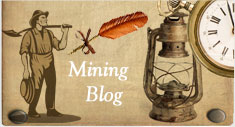Categories
Categories
- $1 Items
- Digitally Archived Documents
- Downloadable Maps
- DVD's and Video's
- Geology and Ore Deposits
- History
- Jewelry Gems Lapidary
- Lode Mining
- Metal Detecting
- Mineral Processing & Metallurgy
- Mining & Geology
- New
- No Category
- Placer Mining
- Prospecting and Exploration
- Publications by Country
- Publications By State
- Rare and Out of Print
- Treasure Hunting
- Home
- Prospecting and Exploration
- Placer Examination Principles & Practice Mining Gold
Placer Examination Principles & Practice Mining Gold
$9.95
Product Description
Rare Publications on Ebook
Placer Examination Principles and Practice
Bureau of Land Management
Technical Bulletin 4
This bulletin has been the defacto standard for Placer Mining since it was first published. It provides a complete picture of how to define a placer, measure its reserves, Sample correctly, Assay, and how to develop the placer into production.
-
PREFACE
-
PART I - REVIEW OF PLACER THEORY AND GEOLOGY
-
1. Placers Defined
-
2. Study of Placers General
-
3. Sources of Valuable Mineral
-
a) Lodes or mineralized zones
-
b) Erosion of pre-existing placer deposits
-
c) Low-grade auriferous conglomerates or glacial debris
-
d) Magmatic segregations and associated basic rocks
-
e) Regional rocks containing particles of valuable mineral
-
4. Weathering and Release Processes
-
a) Ground water
-
b) Temperature change
-
c) Plant growth
-
d) Surface erosion
-
5. Stream Processes Related to Placers
-
6. Concentration of Valuable Minerals
-
a) Bedrock concentrations
-
b) Types of bedrock
-
c) Pay streaks
-
7. Preservation of the Deposit
-
a) Abandonment
-
b) Regional uplift
-
c) Burial
-
PART II - TYPES OF PLACERS
-
1. Residual Placers
-
2. Eluvial Placers
-
3. Stream Placers
-
a) Gulch placers
-
b) Creek placers
-
c) River deposits
-
d) Gravel plain deposits
-
4. Bench Placers
-
5. Flood Gold Deposits
-
6. Desert Placers
-
7. Tertiary Gravels
-
8. Miscellaneous Types
-
a) Beach placers
-
b) Glacial deposits
-
c) Eolian placers
-
PART III - SAMPLING AND EVALUATION
-
1. General Considerations
-
a) Problems
-
b) Industry practice
-
c) Minerals other than gold
-
d) Other factors to be considered
-
e) In brief
-
2. Sampling Guides
-
a) Reconnaissance
-
b) Choosing a sampling method
-
c) Number and size of samples
-
3. Sampling Methods
-
a) Existing exposures
-
b) Hand-dug excavations
-
c) Machine-dug shafts
-
d) Backhoe excavators
-
e) Bulldozer trenches
-
f) Sampling with churn drills
-
g) Bulk samples
-
h) Grab samples
-
i) Drift mine sampling
-
j) Hydraulic mine sampling
-
4. Special Problems
-
a) Large rock or boulders
-
b) Erratic high values
-
5. Uncased or Small-diameter Drill Holes
-
6. Salting
-
7. When Sampling Fails
-
PART IV - SAMPLE WASHING EQUIPMENT
-
1. General Considerations
-
2. Miner's Pan
-
3. Sluice Box
-
4. Rockers
-
5. Special Machines
-
6. Dry Washers
-
PART V - PANNING AND ASSAY PROCEDURES
-
1. Panning
-
2. General Notes on Panning with Suggestions
-
For Improving Procedure
-
3. Fire Assay of Placer Samples Misleading Results
-
4. Procedure For Determining Recoverable Gold in Placer Samples
-
PART VI - NOTES ON GENERAL PRACTICE
-
1. Description of Samples
-
2. Reduction of Sample Volumes
-
3. Reporting Values
-
4. Cost Estimates
-
5. New or Unproven Processes
-
PART VII - CHECK LIST FOR PLACER INVESTIGATIONS
-
1. General Considerations
-
2. Field Guide and Check List (example)
-
PART VIII - GLOSSARY OF PLACERS TERMS
-
APPENDIX
-
A. Placer Sampling Forms
-
B. Gold Price and Value Data
-
C. Water Data
-
D. Placer Drilling Data
-
E. General Information and Cost Data
- F. Conversion Tables
* This document was digitally archived by Sylvanite, Inc. and is not to be used for resale or reproduction. You are not purchasing the original document but a PDF version that will be emailed to you with a downloadable link for your item.


 Loading... Please wait...
Loading... Please wait... 




